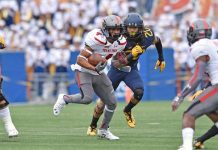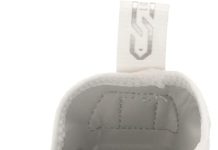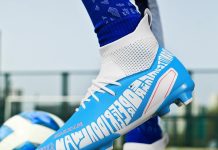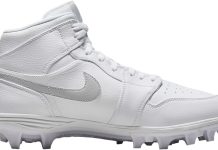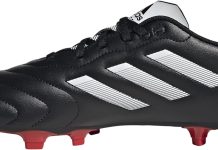In the fast-paced world of modern football, the right pair of cleats can make all the difference. From precision control to lightning-fast speed, today’s football cleats are equipped with cutting-edge technologies that enhance performance on the field. With advances in design, materials, and functionality, players now have a wide range of options to choose from. In this article, we will explore some of the most innovative technologies used in modern football cleats, giving you an insider’s look into the game-changing features that are revolutionizing the way players perform. So lace up your boots and join us on this exciting journey into the world of football cleat technology!
1. Stud Configuration
When it comes to football cleats, one of the most important aspects to consider is the stud configuration. The type of studs used on the sole of the cleats can greatly impact a player’s performance on the field. There are several different stud configurations available, each designed to provide specific advantages depending on the playing surface and player’s style of play.
Review contents
1.1 Conical studs
Conical studs are one of the most commonly seen stud configurations in modern football cleats. These studs have a cone-shaped design and are usually evenly spaced around the sole of the cleat. The conical shape of the studs allows for multi-directional movement and provides good traction on a variety of playing surfaces. This makes them a versatile option suitable for players who require quick changes in direction and agility.
1.2 Blade studs
Blade studs, as the name suggests, have a flat and elongated shape that resembles a blade. These studs are typically aligned in a parallel arrangement along the sole of the cleat. Blade studs offer enhanced stability and traction, especially on firm ground surfaces. They provide a greater surface area for ground contact, which can help distribute the player’s weight and reduce the risk of slipping or losing balance.
1.3 Screw-in studs
Screw-in studs are a popular choice among professional football players due to their versatility. As the name implies, these studs can be easily removed and replaced with different lengths depending on the playing conditions. Screw-in studs offer players the ability to adjust the traction level of their cleats based on the type of surface they will be playing on. If the field is soft and muddy, longer studs can be attached for better grip, while shorter studs can be used for firmer grounds.
1.4 Hybrid studs
Hybrid studs combine the benefits of different stud configurations to offer players a versatile option suitable for various playing surfaces. These studs usually feature a combination of conical and blade shapes. The hybrid design aims to provide excellent traction and stability on different types of fields, allowing players to adapt their cleats to changing conditions. This makes them a popular choice for players who frequently encounter varying playing surfaces.
2. Upper Material
The upper material of a football cleat plays a crucial role in providing comfort, durability, and support to the player’s feet. Different materials are used in the construction of cleat uppers, each offering its own set of benefits and considerations.
2.1 Synthetic materials
Synthetic materials, such as synthetic leather or synthetic mesh, are commonly used in modern football cleats. Synthetic uppers are known for their lightweight nature, flexibility, and durability. They often offer a more affordable alternative to genuine leather cleats while still providing adequate support and protection. Synthetic materials are also generally more resistant to water absorption, making them a popular choice for playing in wet or muddy conditions.
2.2 Leather
Leather has long been a favorite choice among football players due to its natural properties that offer a combination of comfort, durability, and breathability. Genuine leather cleats mold to the player’s foot over time, providing a personalized and snug fit. Leather uppers also have excellent moisture-wicking capabilities, allowing for better breathability and moisture management. However, leather cleats may require more maintenance and can be less resistant to water absorption compared to synthetic options.
2.3 Mesh
Mesh uppers have gained popularity in recent years due to their lightweight and breathable nature. Mesh materials are known for their excellent ventilation properties, allowing for better airflow and preventing excessive heat and moisture build-up inside the cleats. This makes mesh uppers ideal for playing in hot or humid conditions. However, mesh cleats may not offer the same level of durability and support as synthetic or leather options.
2.4 Knit
Knit uppers have revolutionized the football cleat industry with their innovative design and modern appeal. Knitted materials provide a sock-like fit and adaptive support, conforming closely to the contours of the player’s foot. Knit uppers often utilize different knitting patterns and densities to enhance breathability in specific areas while providing targeted support in others. While knit cleats offer a unique and comfortable fit, they may be less durable and protective compared to traditional material options.
This image is property of pop.h-cdn.co.
3. Cushioning and Shock Absorption
Cushioning and shock absorption technologies incorporated into football cleats are crucial in protecting the player’s feet from impact forces and reducing the risk of injuries. The following sections discuss different aspects of cushioning in modern football cleats.
3.1 Midsole cushioning
Midsole cushioning refers to the layer of material placed between the outsole and the insole of the cleat. This layer acts as a shock absorber, reducing the impact forces that can be transmitted to the player’s feet. Different materials, such as foam or gel, may be used in the midsole to provide varying levels of cushioning and responsiveness. Cleats with adequate midsole cushioning can help prevent fatigue and discomfort during long matches or intense training sessions.
3.2 Heel cushioning
Heel cushioning is particularly important for football players who frequently engage in activities that involve landing or jumping. Cleats with advanced heel cushioning technologies, such as air capsules or foam inserts, can help absorb and distribute the forces generated during these movements. Proper heel cushioning can help reduce the risk of heel-related injuries, such as plantar fasciitis or Achilles tendonitis.
3.3 Forefoot cushioning
The forefoot area of a football cleat is subject to high stress and impact during running, cutting, and kicking. Cleats with enhanced forefoot cushioning can help lessen the strain on the player’s forefoot, providing a more comfortable and responsive experience. This type of cushioning is often incorporated into the midsole or outsole of the cleat to improve shock absorption and energy return.
4. Traction Enhancements
Traction is crucial in football, as it enables players to accelerate quickly, change direction, and maintain stability during various movements. Modern football cleats incorporate several traction-enhancing technologies to optimize the player’s grip on the playing surface.
4.1 Traction plates
Traction plates are rigid structures built into the outsole of the cleat, typically made of lightweight materials such as carbon fiber or plastic. These plates are strategically placed to provide additional support and stability, as well as to distribute the player’s weight evenly across the cleat. Traction plates can improve traction by preventing excessive bending or twisting of the sole, especially during quick turns or lateral movements.
4.2 Traction patterns
The design and arrangement of the studs or traction elements on the sole of a football cleat greatly influence its traction capabilities. Cleats may feature various stud patterns, including a combination of conical, bladed, or even unique-shaped studs. These patterns are optimized for specific playing surfaces, allowing for better grip and traction during different movements. Traction patterns are often developed based on extensive research and testing to ensure optimal performance.
4.3 Traction-increasing technologies
In addition to stud configuration and patterns, modern football cleats may incorporate additional technologies to further enhance traction. Some cleats feature sticky rubber compounds on the outsole, which provide better grip on various surfaces. Others may utilize micro-textured surfaces or raised patterns on the studs to increase friction and traction. These traction-increasing technologies work together to maximize the player’s ability to generate and maintain traction while minimizing the risk of slips or falls.
This image is property of hips.hearstapps.com.
5. Arch Support and Stability
Proper arch support and stability are essential for football players to prevent injuries and maintain optimal performance. Football cleats employ various technologies and features to provide the necessary support and stability during intense movements on the field.
5.1 Arch support technologies
Arch support technologies in modern football cleats aim to provide a balanced and supportive platform for the player’s feet. Cleats may incorporate molded arch supports or inserts made of materials like foam or gel. These supports help distribute weight evenly across the foot, reducing the risk of excessive strain on the arch and minimizing the chances of conditions like plantar fasciitis or arch collapse. Proper arch support can also contribute to better overall balance and stability.
5.2 Ankle support technologies
Ankle injuries are common in football, and proper ankle support can help mitigate the risk of sprains or strains. Many modern football cleats incorporate ankle support technologies, such as ankle collars or high-top constructions. These features provide additional stability and promote proper ankle alignment during dynamic movements. Ankle support technologies are designed to minimize excessive ankle movement while still allowing for the necessary range of motion for optimal performance.
5.3 Lateral stability features
Lateral stability is crucial in football, as players often make quick lateral movements during games or training. Cleats with lateral stability features aim to prevent excessive side-to-side motion and provide a secure base during these actions. This can include reinforced midsole or outsole materials, anti-rollover systems, or specialized tread patterns that offer additional support and grip. Lateral stability features help diminish the risk of ankle rollovers and improve overall balance and control on the field.
6. Breathability and Moisture Management
Proper breathability and moisture management in football cleats are vital for comfort and foot health. Extended periods of intense physical activity can cause excessive sweating, leading to discomfort, blisters, and an increased risk of infection. Cleats with effective breathability and moisture management technologies can help alleviate these issues.
6.1 Ventilation systems
Modern football cleats often incorporate ventilation systems, such as mesh panels or strategic perforations, to promote airflow within the cleat. These systems allow heat and moisture to escape, reducing the chances of excessive sweat buildup and maintaining a more comfortable internal climate. Ventilation systems contribute to improved breathability, preventing odors and moisture-related issues, and providing a fresh and cool feeling during matches or training sessions.
6.2 Moisture-wicking materials
Moisture-wicking materials are commonly used in the construction of football cleats to help manage sweat and moisture. These materials, often synthetic blends or specific moisture-wicking fabrics, have the ability to draw moisture away from the skin and transport it to the outer surface of the cleat, where it can evaporate more easily. This helps keep the feet dry and comfortable, reducing the chances of blisters, irritations, or fungal infections caused by prolonged exposure to moisture.
This image is property of pop.h-cdn.co.
7. Weight Reduction
The weight of football cleats can significantly impact a player’s performance, agility, and overall comfort. Manufacturers employ various strategies to reduce the weight of cleats without sacrificing essential features and performance capabilities.
7.1 Lightweight materials
Advancements in lightweight materials, such as advanced synthetics or engineered composites, have allowed football cleats to become significantly lighter without compromising durability or support. Cleat uppers and outsoles made from lightweight materials can minimize the overall weight of the cleat, enabling players to move more freely and with less restriction. Lightweight materials can also help reduce fatigue during extended play, allowing players to maintain their performance levels for longer periods.
7.2 Minimalist designs
Minimalist designs aim to eliminate unnecessary or excess materials from the construction of football cleats. This reductionist approach focuses on creating cleats with only essential components, resulting in a streamlined and lightweight product. Minimalist designs often prioritize flexibility, freedom of movement, and a more natural feel on the field. Cleats with minimalist designs are often preferred by players who value lightweight footwear and a closer connection to the playing surface.
7.3 Hollowed-out components
Some football cleats feature hollowed-out components to further reduce weight while maintaining structural integrity. This technique involves strategically removing material from specific areas of the cleat, such as the midsole or outsole, while preserving necessary support and functionality. Hollowed-out components help distribute weight more efficiently, making the cleats feel lighter and more responsive. This weight reduction can translate into improved maneuverability and enhanced performance during play.
8. Customization and Fit
Achieving the perfect fit and customization options can greatly enhance a player’s comfort, confidence, and performance on the field. Football cleats incorporate various technologies and features to cater to individual preferences and optimize fit.
8.1 Laceless technology
Laceless technology eliminates the need for traditional laces, offering a more streamlined and glove-like fit. Cleats with laceless systems often utilize alternative closure mechanisms such as straps, zippers, or elastic materials to secure the cleat snugly around the foot. This technology provides a consistent fit and reduces the risk of discomfort or pressure points caused by loosely tied or incorrectly adjusted laces.
8.2 Adjustable fit systems
Adjustable fit systems allow players to fine-tune the fit of their cleats to meet their specific needs. These systems often involve adjustable components, such as straps or bands, that can be tightened or loosened to achieve a personalized fit. Cleats with adjustable fit systems offer players more control over the snugness and support provided by the cleats, accommodating different foot shapes and providing a customizable experience.
8.3 Customizable components
Some football cleats allow for the customization of specific components to meet individual preferences or performance requirements. This customization may involve removable insoles or interchangeable inserts that can be tailored to provide different levels of cushioning, arch support, or shock absorption. Cleats with customizable components offer players the opportunity to fine-tune their footwear to match their unique playing style and specific needs.
This image is property of media.wired.com.
9. Injury Prevention
Injury prevention is a crucial aspect of football cleat design. Cleats incorporate various features and technologies to help reduce the risk of common injuries and protect vulnerable areas of the feet.
9.1 Ankle braces and supports
Ankle braces and supports are often integrated into the design of football cleats to enhance stability and reduce the chances of ankle sprains or other lower extremity injuries. These braces or supports can be built into the ankle collar of the cleat or provided as separate accessories. Ankle braces and supports aim to limit excessive ankle movement while still allowing for necessary range of motion, providing players with added protection during intense physical activity.
9.2 Padding and reinforced areas
Cleats may incorporate padding and reinforced areas in key zones of the foot to provide additional protection against impact and abrasions. Common areas that receive extra padding or reinforcement include the toe box, heel, and vulnerable areas along the sides of the foot. These features help reduce the risk of contusions, blisters, and other injuries caused by direct impact or friction. Well-designed padding and reinforcements contribute to a more comfortable and protective cleat.
9.3 Toe protectors
Toe protectors are often found in football cleats to guard against injuries caused by collisions or impacts. These protective features cover and reinforce the toe area, reducing the risk of toe fractures, contusions, or abrasions. Toe protectors can be made from various materials, such as rubber or thermoplastic urethane, and are designed to withstand high forces encountered during the game. This additional layer of protection can give players more confidence and reassurance on the field.
10. Smart Cleat Technologies
With the rapid advancement of technology, smart cleat technologies have emerged to provide players with valuable performance data and insights. These technologies integrate sensors and tracking systems into the cleats, allowing for real-time analysis of various biomechanical and positional metrics.
10.1 GPS tracking systems
GPS tracking systems incorporated into football cleats enable players and coaches to gather accurate data on player movements, speed, and distance covered during training or matches. The built-in GPS sensors provide information about positioning, acceleration, deceleration, and changes in direction. This data can help players analyze their performance, identify areas for improvement, and track progress over time. GPS tracking systems also offer coaches valuable insights for team training, strategy development, and player management.
10.2 Biomechanical sensors
Biomechanical sensors embedded in football cleats provide feedback on specific movements and forces experienced by players’ feet and lower limbs. These sensors can measure parameters such as ground reaction forces, pressure distribution, and joint angles. By analyzing this data, players and coaches can gain insights into running technique, stride patterns, and potential biomechanical imbalances that may contribute to injuries or affect performance. Biomechanical sensors in cleats offer a valuable tool for injury prevention, performance optimization, and biomechanical analysis.
10.3 Smart insoles
Smart insoles take the concept of smart cleat technologies further by providing detailed foot-specific data to players. These insoles are equipped with various sensors that capture information such as pressure distribution, foot strike pattern, and gait analysis. The data collected by smart insoles can help players understand their individual foot mechanics and make adjustments to improve performance or prevent injuries. Smart insoles can also provide real-time feedback during training or matches, allowing players to make immediate modifications to their technique or movement patterns.
In conclusion, modern football cleats incorporate a wide range of technologies to enhance performance, comfort, and safety on the field. From stud configurations and upper materials to cushioning technologies and smart cleat features, these advancements aim to provide players with the best possible equipment to succeed in the game while reducing the risk of injuries. As football continues to evolve, so will the technologies used in cleat design, ensuring that players have every advantage possible to excel in their sport.
This image is property of iowastatedaily.com.










